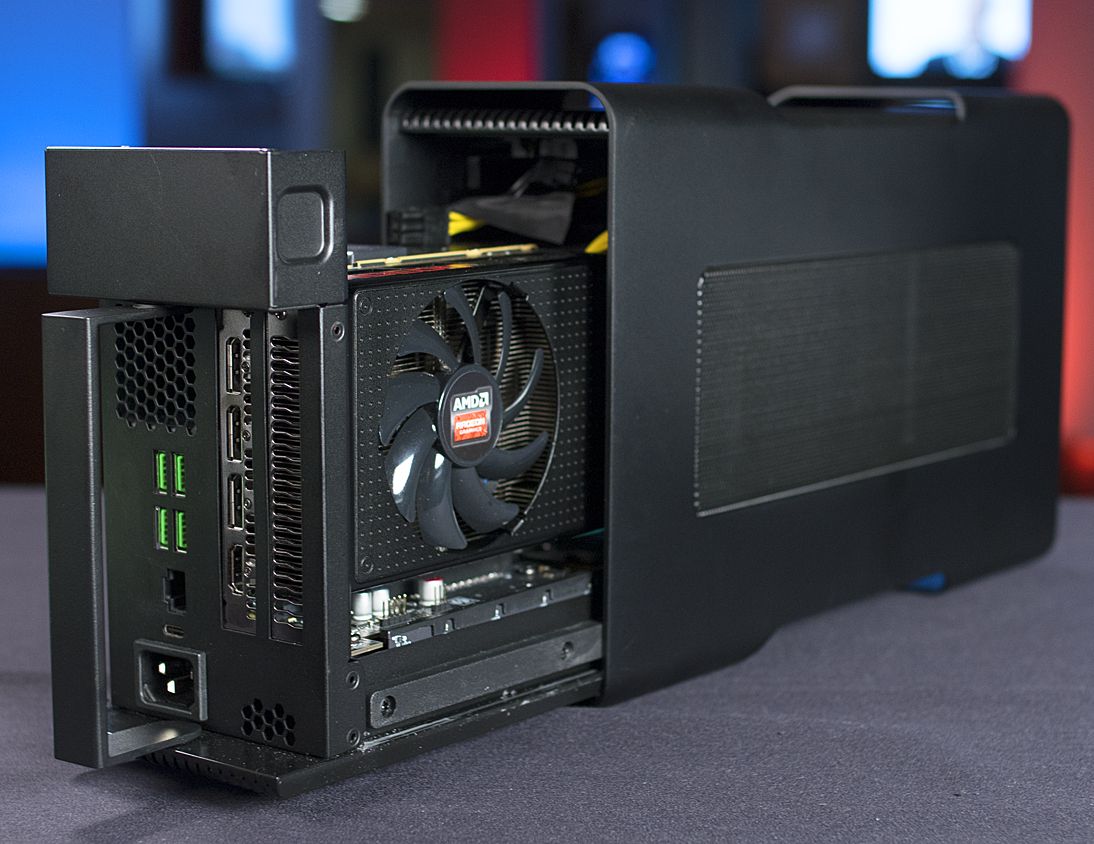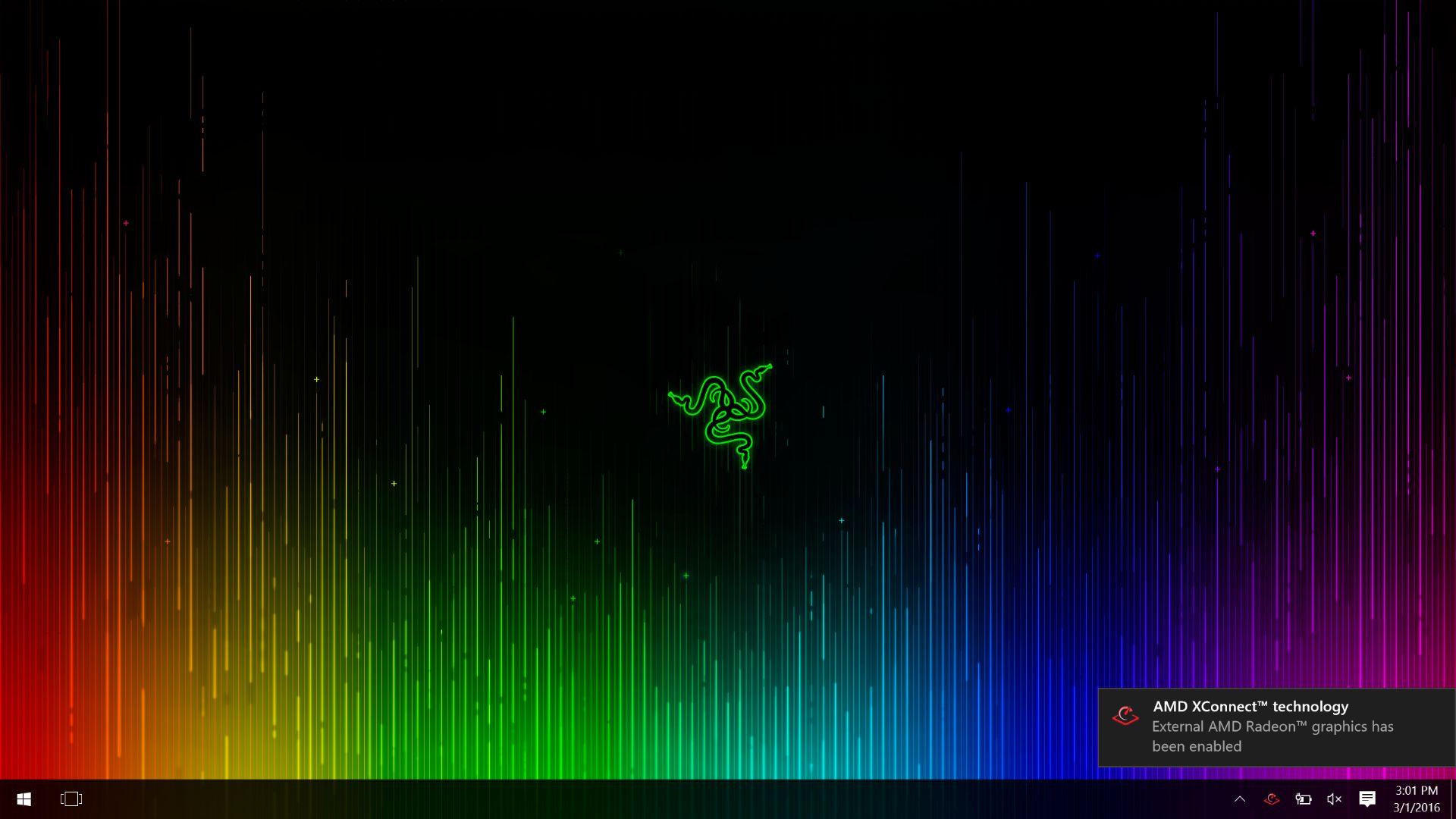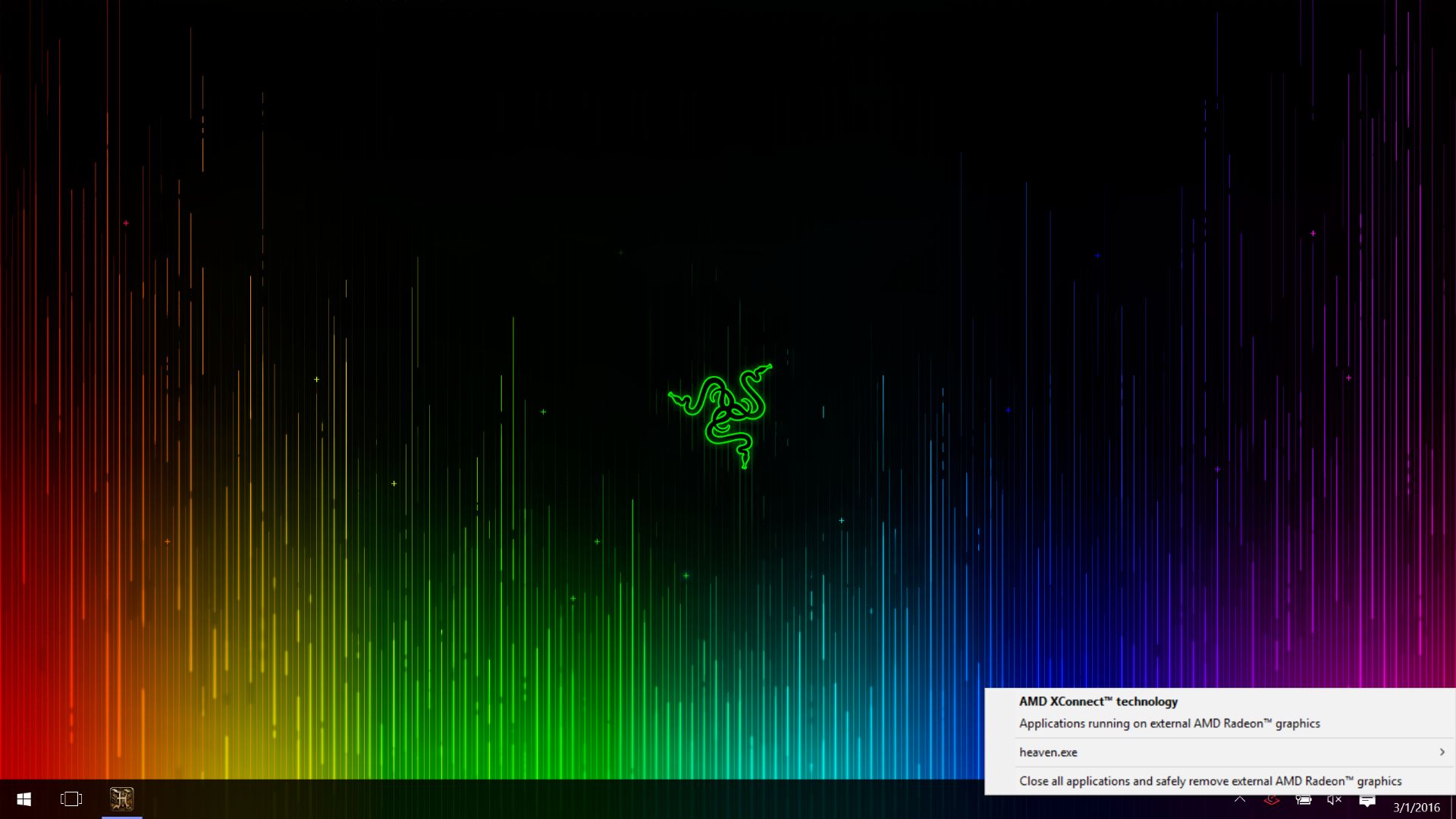AMD Introducerer "AMD XConnect™"

Vi kender det alle sammen, skal jeg vælge den dejlig lette ultrabook, eller den hardcore gamer bærbare der så til gengæld vejer som et hus. Nu kommer AMD med løsningen på dit problem
AMD lancerer i dag, deres nye "AMD XConnect™ teknologien" som skal være med til at løse de problemer, vægt kontra kræfter, som vi alle kender når vi skal vælge bærbar. Tidligere forsøg på at løse problemet har mildest talt ikke været hverken bruger venlige eller til at betale for den almindelige forbruger.
AMD XConnect™ teknologien vil gøre det nemmere end nogensinde at tilslutte et eksternt grafikkort, dog skal det være AMD for at virke. Det er muligt at tilslutte og frakoble grafikkort "on the fly" altså uden at det påvirker det du sidder og laver ved din computer.
Her er den presse meddelse som vi har modtaget fra AMD:
A Brief History of External Graphics High-end mobile users have always sought ways to use stationary hardware to improve mobile computing, going back to the first docking stations and the portable systems they paired with. Ever since PCI Express® replaced AGP as the dominant expansion standard for GPUs, many end-users have been asking for ways to attach a high-end external graphics card to a laptop computer. Modern laptops have evolved a great deal in the past decade, with faster peripheral connections, high-resolution displays, solid-state storage, dual-and-quad-core processors, and, in many cases, support for multiple monitors using DisplayPort™ or HDMI®. Despite these advantages, no method for connecting a high-end external GPU has won broad industry support.
Early industry attempts to build external graphics solutions relied on the then-new EXPRESSCARD™ standard, which offered a single channel of PCI Express® 1.0 connectivity. However, the bandwidth from a single PCI Express® 1.0 link was modest, and few systems supported this option.
When ATI Technologies Inc. (ATI) introduced the ATI XGP™ (External Graphics Platform) in 2008, XGP solved for bandwidth constraints with initial support for eight lanes of PCI Express® 2.0 connectivity and a second-generation version of the standard that could have supported a full x16 graphics card.
ATI partnered with Japan Aviation Electronics Industry, Limited (JAE) to design a new custom cable that could deliver the necessary bandwidth in a smaller form factor than was previously possible, while the XGP connector could mount to any motherboard that could supply eight or more lanes of PCI Express® 2.0 connectivity. The ATI XGP external box was designed to provide additional USB ports through a simple USB 2.0 hub, but the platform could hypothetically accommodate additional features and capabilities.
The ATI XGP platform also included support for native PCI Express® hot plugging under Windows Vista®—a feature that remains elusive in the world of external graphics today. XGP could even output directly to the laptop's display, rather than requiring a separate monitor. This, too, is unusual even in today’s external GPU solutions.
The ATI XGP platform plainly solved many of the issues related to external graphics, however XGP was not without limitations. The custom-designed cables by JAE would be considered large relative to modern notebook form factors, and the XGP hardware platform was only compatible with ATI video cards. As a result, ATI XGP devices only shipped alongside a small number of systems.
Today, several vendors have created their own external GPU platforms, with varying levels of performance and limited support for features like hot plugging.
Introducing AMD XConnect™ Technology Available starting 10 March, 2016 in Radeon Software 16.2.2 (or later), AMD XConnect™ technology is an important piece of a three-party effort designed to solve the problems that have kept external graphics solutions from achieving mass market success. Developed in collaboration with Intel’s Thunderbolt™ group and Razer Inc., it is the first graphics driver qualified for use with validated Thunderbolt™ 3 external graphics (eGFX) solutions on Windows® 10.
Rather than relying on large and/or proprietary cables, AMD XConnect™ is compatible with simple/reversible Thunderbolt™ 3 (USB-C™) cables and connectors, and conforms to eGFX requirements of the Thunderbolt™ 3 specification. Four PCI Express® lanes are provided by Thunderbolt™ 3, which gives the external solution up to 40Gbps of bandwidth (equivalent to a PCI Express® 3.0 x4 slot).
AMD has invested significant effort in the detachable graphics architecture of its own driver stack to support these capabilities, and has worked closely with Intel’s Thunderbolt™ group to qualify a range of gaming-class AMD Radeon™ graphics cards for the Thunderbolt™ 3 spec.
QUALIFIED RADEON™ GRAPHICS CARDS: ? AMD Radeon™ R9 Fury ? AMD Radeon™ R9 Nano ? AMD Radeon™ R9 300 Series ? AMD Radeon™ R9 290X ? AMD Radeon™ R9 290 ? AMD Radeon™ R9 280 ? Mobile derivatives of these ASICs ? PLANNED: Radeon™ dGPU products based on the Polaris architecture
VALIDATED THUNDERBOLT™ 3 SYSTEM REQUIREMENTS: ? Radeon Software 16.2.2 (or later) ? 1x Thunderbolt™ 3 port ? 40Gbps Thunderbolt™ 3 cable ? Windows® 10 build 10586 (or later) ? System BIOS ACPI extensions for Thunderbolt™ eGFX (check with vendor) ? Thunderbolt™ firmware (NVM) v.16 (or higher) ? Pass Thunderbolt™ certification
AMD expects that validated Thunderbolt™ 3 eGFX solutions will ship in a diverse variety of form factors in the months ahead, including compact integrated devices or larger upgradeable enclosures suitable for user-upgradeable discrete graphics. In the event an upgradeable chassis is selected, users must vet the manufacturer’s thermal/electrical/physical enclosure specifications against the desired GPU to determine specific support.
Nevertheless, gamers and enthusiasts will be able to use these qualified products in any suitable external graphics chassis that’s validated to meet the eGFX requirements of the Thunderbolt™ 3 specification without permanently sacrificing the portability of a thin’n’light notebook in pursuit of desktop-class graphics performance.
Furthermore, PC users that configure a validated Thunderbolt™ 3 eGFX enclosure with a qualified Radeon™ GPU will not have to reboot their systems or give up hibernation capabilities to utilize such enclosures. AMD XConnect™ also ensures that validated Thunderbolt™ 3 eGFX solutions can seamlessly switch between discrete and integrated graphics with no interruption to the host system.

AMD XConnect™ utilizes Windows ®10 UI toasts keep the user apprised of the status of their external Radeon™ GPU.
Finally, the AMD XConnect™ technology driver is also capable of identifying which applications are running on external graphics at any given time. While the driver and system are designed to remain functional if the eGFX chassis is unexpectedly disconnected via “surprise removal” handling routines, this process necessarily terminates eGFX applications. Providing a list of running applications via the system tray helps ensure that the end-user doesn’t experience inadvertent data loss or application hang.

Like a USB flash drive, AMD XConnect™ provides a convenient system tray management interface to manage or safely remove Radeon-powered eGFX devices.
AMD XCONNECT™ TECHNOLOGY 4
The Razer Blade Stealth and Razer Core The first shipping AMD XConnect™-compatible system is the Razer Blade Stealth Ultrabook™ with Thunderbolt™ 3 and its accompanying external graphics chassis, the Razer Core™. The Razer Blade Stealth is a 12.5-inch Ultrabook™ with 8GB of LPDDR3-1866 memory, up to 512GB of solid-state storage, and an Intel Core i7-6500U processor. Two different displays are available: a 2560x1440 touch IGZO display or a 3840x2160 touch IGZO option. All of the Razer Blade Stealth SKUs are validated for Thunderbolt™ 3 external graphics and correspondingly compatible with AMD XConnect™ technology when the Razer Core is configured with a qualified Radeon™ GPU.
The Razer Blade Stealth uses its Intel HD Graphics 520 GPU when disconnected from the Razer Core, but seamlessly switches to a qualified Radeon™ GPU once the Razer Core is connected. The Razer Core is an external GPU chassis with support for one double-wide PCI Express x16 graphics card and a maximum power draw of 375W. The Razer Core includes 4x USB 3.0 ports, a gigabit Ethernet port, and one Thunderbolt™ 3 port. The Thunderbolt™ 3 port doesn’t just provide support for all categories of Thunderbolt™ devices, it can also charge the Razer Blade Stealth via the Razer Core.
The 40Gbs Thunderbolt™ 3 connection is capable of providing gigabit Ethernet and USB 3.0 support while the external GPU is in use, without performance degradation or latency spikes.
AMD XCONNECT™ TECHNOLOGY 5
The Razer Core configured with an AMD Radeon™ R9 Nano GPU, activating compatibility with AMD XConnect™ technology when the user installs Radeon Software 16.2.2 (or later) on the Razer Blade Stealth.
The Razer Core also supports Razer Chroma™. Razer Chroma™ is a full-spectrum lighting and display technology that allows users to program supporting devices with a variety of effects and up to 16.8 million colors. With two separate Chroma™ zones, the Razer Core™ can cycle through its color palette, animate with waves of color, maintain static illumination, or create a rippling effect across the device.
The Razer Stealth Blade™ and Razer Core™ exemplify the kind of no-compromise solution AMD XConnect™ is designed to enable. Until now, gamers have often been forced to choose between ultraportable systems with relatively weak graphics solutions and large, heavy desktopreplacement devices with top-end GPUs. The combination of AMD XConnect™ and Thunderbolt™ 3 means that enthusiasts can enjoy high-end desktop gaming performance, then disconnect a single Thunderbolt 3 cable and use their ultraportable notebook.
AMD XCONNECT™ TECHNOLOGY 6
A Three-Party Technology Collaboration Thunderbolt™ 3 is a vital component of the three-way collaboration, as it contains specific eGFX requirements that pave the way for powerful external graphics cards and graphics drivers that deliver an intuitive and consistent experience. Based on these requirements, OEMs can now design a range of solutions such as small boxes designed for mobile Radeon™ GPUs, or larger upgradeable chassis like the Razer Core™. Intel demoed both types of device at IDF in August 2015.
Both categories of prototypical enclosures demonstrated at IDF 2015 utilized AMD Radeon™ graphics cards, where the smaller form factors offered: audio-out jacks, 2x HDMI® ports, 2x DisplayPort™ connections, 2x USB 3.0 ports, and a gigabit Ethernet port alongside an AMD Radeon™ R9 M385 GPU. The larger prototypical eGFX chassis bore a Radeon™ R9 200 series GPU.
Correspondingly, Razer Ltd. had the technical expertise to be the first OEM to implement the Thunderbolt™ 3 eGFX requirements in shipping hardware. The learnings and best practices generated by Razer’s effort have been selflessly upstreamed to relevant industry parties to simplify market entry for future Thunderbolt™ 3 eGFX market participants. As a result, other OEMs are now free and encouraged to design their own Thunderbolt™ 3 solutions, provided they conform to the Thunderbolt™ 3 eGFX requirements and platform requirements previously described.
Ultimately, the combined resources of AMD, Razer and the Intel Thunderbolt™ group has fostered an external graphics ecosystem model that solves problems that confined previous efforts to niche markets. In the future, it is envisioned that consumers be able to choose from a variety of vendors when purchasing an external chassis, just as they currently choose between different vendors when purchasing a Radeon™ graphics card.
Regardless of whether the eGFX market matures horizontally or vertically, such solutions promise to finally realize the dream of many gamers: on-demand performance, small and standardized cables, and compatibility with otherwise compact and portable systems. Configuring these platforms with a qualified Radeon™ graphics solution will ensure a robust and easy experience with AMD XConnect™ technology.









